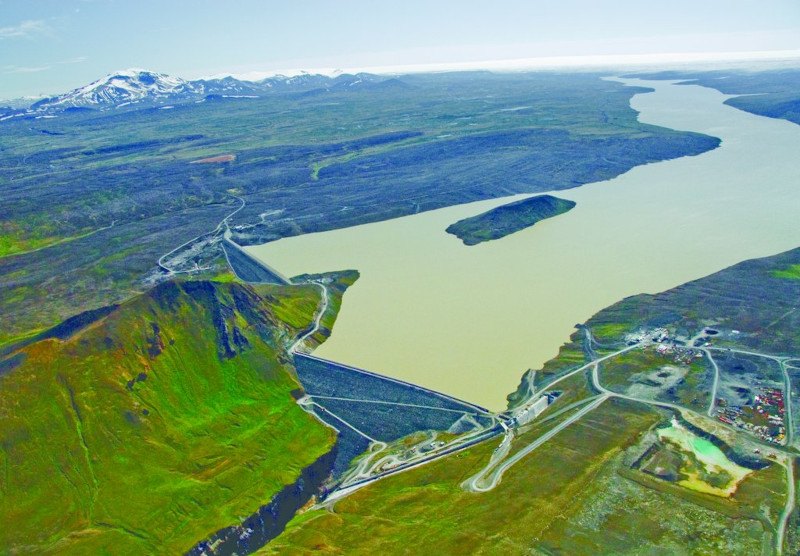The Kárahnjúkar Hydroelectric Project in East-Iceland was concluded in the fall 2007. It harnesses two glacial rivers, Jökulsá á Dal and Jökulsá í Fljótsdal, originating in the Vatnajökull glacier. Installed power is 690 MW, and maximum flow is about 144 m³ per second, which ensures an annual generating capacity of about 4,600 GWst.
Kárahnjúka dam is a concrete faced rockfill dam, 700 m long and 198 m high. It is among the largest of its kind in the world, and the highest in Europe. These dams form the Hálslón reservoir, which is 57 km² and reaches the edge of Brúarjökull glacier. The water level when full is 625 m above sea level.
The total head at the project is 599 meters, and total tunnel length is 72 km. The headrace tunnels and parts of the adit tunnels are drilled with full-face boring machines, while shorter tunnels are blasted. Two 220 kV high-tension lines from the substation in Fljótsdalur run to the Alcoa aluminum smelter in Reyðarfjörður.
Before the project, the communities in East Iceland were experiencing a steady decline in population and local economy. Very high hopes of prosperity and employment thus existed among the local inhabitants of the area.
In 2010, the Research Centre of the University of Akureyri (RHA) published a study on the effects of the project on the Icelandic society between 2002-2008. Main effects as described by RHA in the report on social and economical effects are:
Population: The most effects were in the area two hours away from the main construction. The population increased from 7758 to 9445, of 1700 people or 22%, in the years 2002-2008.
Foreign workers: More foreign workers came to Iceland then expected. Iceland was not ready for this increase, which caused clashes between the government and the contractors on site. The contractors failed to compile with tax regulations for some time. The unemployment rate in Iceland was around 2% at the time, but 1.2% in the area close to constructions.
Economical effects: The direct economical effects of the construction of the Kárahnjúkavirkjun and the aluminum smelter of Alcoa in Reyðarfjörður were less then expected. The total cost of Kárahnjúkavirkjun was around 88 million Euros, with one third going straight to Icelandic designers, Icelandic contractors, buying material etc. The aluminum smelter cost around 80 million Euros with around 22 millions going to Icelandic parties. It’s hard to predict how much of this stayed in the eastern part of Iceland.
Kárahnjúkavirkjun: Overall social effects of the power plant are positive. People are employed and taxes paid. Jobs are also created around the plant as well as research etc. The whole experience is also considered positive for contractors and specialists. The electricity generated is sold to Alcoa.
Alcoa: Almost 500 people were employed in the smelter in December 2009. Jobs around the smelter are around 300. Alcoa buys the energy, employee’s people and also works for the community with grants and other acts.
Other: Jobs in the east increased and salaries raised, the local business made bigger profits and local infrastructures strengthened. Tourism also increased.
Main problems: Housing was a big problem for the east of Iceland. Around 135 thousand m2 were built in the east until the end of 2008. The need was thought to be 70-80 thousand m2. The price of houses grew a lot but mostly went down after the construction. In October 2009, a total of 218 apartments were empty. Most of them were in apartment buildings with numerous flats. This is typical for a "ghost town".
The region's population and economy had been in relative decline for decades with only a limited diversity of jobs available and a continuing dependence on the primary sector which had been rationalized and thus required a declining amount of manpower. The age and sex distribution showed signs of lengthy out-migration, primarily to the Reykjavík area, with relatively few young adults and women remaining.
Local inhabitants of the area had high hopes of prosperity and employment when the project was launched. Environmental concerns were raised, mainly by environmental groups from outside the region. An environmental impact assessment (EIA) was performed and construction was started. During the construction period, the region witnessed a significant increase in activity and investment in the projects, as well as in the housing sector and in other aspects of infrastructure. Shifts in employment have been observed, with a marked decline in fish processing jobs.
Sources:Megaprojects in the Circumpolar NorthKárahnjúkar websiteRHA









